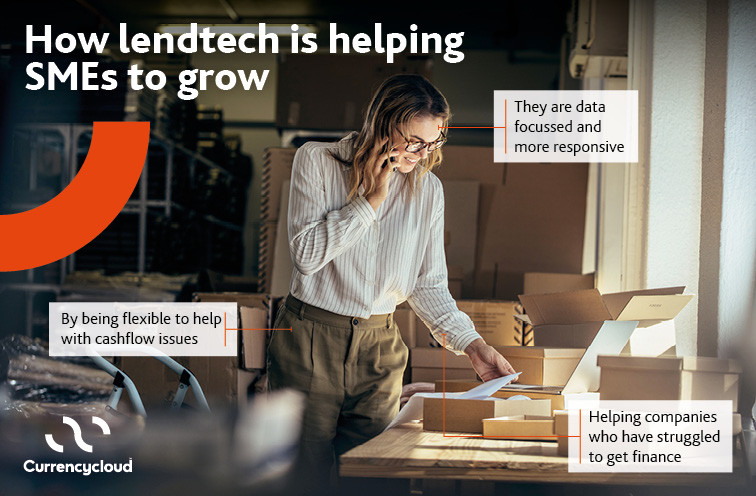There has never been a better time for SMEs to seek the funding they need to grow their businesses. New ways of lending (lendtech) by a broader range of players mean an SME’s options for funding are now well and truly open.
This hasn’t always been the case. So-called ‘information asymmetry’ made it difficult for banks to find the right data to judge whether a small venture would be a good risk or not. Larger businesses are obliged to make financial information available and have a longer track record to consider.
Read more:
So not only would it take as long (or longer) to put together an accurate picture for SMEs as it would for corporates, but the value of charges made against loans would be much smaller and the likelihood of an SME going out of business much greater.
New tech is helping SMEs grow
The global economic recession encouraged banks to tighten their lending criteria to avoid the risk of further losses, making it even more difficult for SMEs to secure lending. Since then, a raft of innovative new start-ups and tech companies have stepped into the breach to help SMEs achieve their growth plans.
Ecommerce companies such as Amazon and Alibaba, for example, provide finance to merchants trading on their platforms, while peer-to-peer lenders provide direct loans or fund SMEs via invoice financing. And the advent of open banking has opened the way for a whole new breed of alternative lenders, or ‘lendtech’ firms that exist solely to provide loans for SMEs.
Alternative lenders are thriving
Open banking means alternative lenders can share information from banks about SMEs and blend it with their own data sets to create a detailed picture of an SME and their propensity to repay – or default – on a loan. Lenders can also link to small businesses’ accounting systems so they can see financials like turnover and profit first hand, eliminating the need for the SME to re-enter data into an application form.
There are five key reasons why alternative lenders are now in exactly the right place at exactly the right time.
Superior data analytic capabilities: Alternative lenders can make faster and more accurate decisions based on open data sources. The data they use does not have to be confined to historical business performance, forecasts or current finances.
It can be expanded to include market sentiment, wider trends in a specific sector or sub-sector or even micro-economic factors such as the weather. Time to cash is reduced from weeks to hours and the quality of lenders’ decision-making is improved significantly.
A seamless customer experience: Alternative lenders have built customer journeys that align to SME expectations. Unlike traditional banks, digital-first alternative lenders have been in the enviable position of being able to design their processes and customer interfaces with SMEs in mind from the start. Clean, simple and paper-free apps accessible from any device at any time can make applying for a loan as easy as any B2C ecommerce transaction.
Lendio, which connects small businesses with an appropriate list of potential lenders within hours, says its online application takes just 15 minutes to complete, for example.
Flexibility: Alternative lenders can offer a wider range of instruments such as invoice financing, equipment loans and revolving lines of credit. Some, like iwoca, clearly show how much additional funding could be accessed without having to reapply, as well as how to make early payments.
Invoice financing, where a lender provides funds against outstanding sales invoices, helps businesses to improve cash flow, pay employees and suppliers, and reinvest in operations and growth.

Reaching the underserved: SMEs that would have been rejected by traditional banks can be catered for by alternative lenders who take a wider range of factors into account.
Estimates suggest that a high proportion of lending decisions by banks are rejected because SMEs fail to meet basic criteria. One of the main reasons why alternative lenders are succeeding is that they can cast their net for customers more widely, applying terms and interest rates appropriately to match risk profiles.
As with consumer lending, SMEs can rebuild their credit records by successfully paying back their loans on time – creating the right conditions to borrow further funds in future.
Offering more: Alternative lenders recognize that they will build customer loyalty and more business if they can create ‘hubs’ for their customers. These can provide useful information sources and additional services, such as FX and cross-border payments from trusted third parties like Currencycloud.
Instead of having a one-off transactional relationship with customers, they can become a go-to destination for everything an SME needs to manage its business more effectively, including expense management, know-your-customer checks and market insights. Not only will this encourage SME loyalty, but it also opens up potential new sources of income.
As EY writes in its report The Future of SME Banking: “In the face of constant competition within the SME banking market, providers need to provide a broader, more integrated offering with relevant value-add services. The provision of services beyond those traditionally offered within the core banking proposition will enable access to new revenue pools that may have been previously inaccessible.”
Unlocking economic potential
Technology is at the heart of the current success of alternative lenders, from their ability to act as hubs by partnering with other providers in their ecosystem to helping new and growing ventures access finance.
And alternative lenders play an important role: SMEs are vital contributors to the global economy, creating new jobs and the corporates of the future. If SMEs are prevented from securing the funds they require to digitize their businesses, say, to employ more people or buy new manufacturing equipment, they will fail to thrive.
By coming up with new ideas for providing loans to SMEs, alternative lenders are not just filling a gap, they are also unlocking huge potential in the global economy. As open banking and collaboration between accounting software providers, banks, alternative lenders and other third parties continue to evolve, we can expect to see even more innovative approaches to SME lending in the near future.
New eBook: “Why the future of payments is modular and cloud-based”
Modular, cloud-based payments technology is the way of the future, and the fintech companies that don’t embrace this new payments era will quickly fizzle out.
Our new guide, “Why the future of payments is modular and cloud-based” will tell you everything you need to know about the latest innovations in the payments world.




